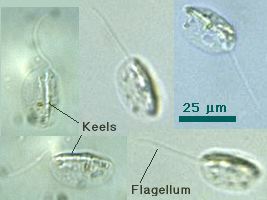 Genus: Only 1 emergent flagellum; locomotory flagellum directed anteriorly, straight, during swimming;
colourless, phagotrophic; no eyespot; rigid, solitary, ovoid, usually flat, with several keels; freshwater
(Illustrated Guide, 1985).
Oval or pyriform; not plastic; pellicle often with straight or spiral furrow; a single flagellum; many species
(Kudo, 1966).
Genus: Only 1 emergent flagellum; locomotory flagellum directed anteriorly, straight, during swimming;
colourless, phagotrophic; no eyespot; rigid, solitary, ovoid, usually flat, with several keels; freshwater
(Illustrated Guide, 1985).
Oval or pyriform; not plastic; pellicle often with straight or spiral furrow; a single flagellum; many species
(Kudo, 1966).
Species: 30-35 μm; 2 dorsal, 2 ventral grooves on either side of dorsal and ventral keels (How to know the protozoa, 1979).





